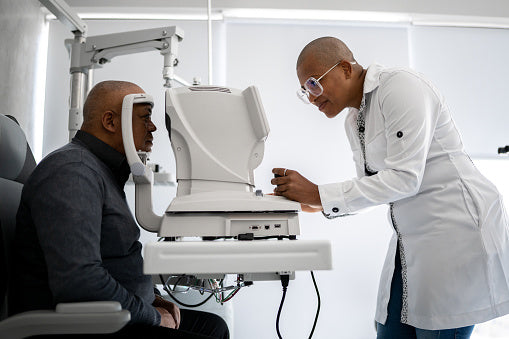
Stigmatism and Astigmatism: Understanding the Differences and Similarities
Share
Stigmatism and astigmatism are two common eye conditions that can affect vision quality. While both conditions involve the curvature of the cornea or lens, they have distinct differences and similarities. In this article, we will explore the causes, symptoms, diagnosis, treatment, and prevention of stigmatism and astigmatism, as well as the differences and similarities between the two conditions.
Understanding Stigmatism
Stigmatism is a refractive error that occurs when the cornea or lens is not evenly curved, causing light to focus on multiple points instead of a single point on the retina. This can result in blurred or distorted vision at any distance. Stigmatism can be caused by a variety of factors, including genetics, injury, or surgery. There are three types of stigmatism: myopic (nearsighted), hyperopic (farsighted), and mixed. Symptoms of stigmatism may include headaches, eye strain, and difficulty seeing at night.
Diagnosis of stigmatism is typically done through a comprehensive eye exam, including a visual acuity test, a refraction test, and a corneal topography test. Treatment for stigmatism typically involves corrective lenses, such as glasses or contact lenses, to help focus light on the retina properly. Refractive surgery, such as LASIK or PRK, may also be an option for some patients.
Understanding Astigmatism

Astigmatism is also a refractive error that occurs when the cornea or lens is not evenly curved. However, astigmatism causes light to focus on multiple points at different angles, resulting in distorted or blurred vision at all distances. Astigmatism can be caused by a variety of factors, including genetics, injury, or surgery. There are two types of astigmatism: regular and irregular. Symptoms of astigmatism may include blurred vision, eye strain, headaches, and difficulty seeing at night.
Diagnosis of astigmatism is typically done through a comprehensive eye exam, including a visual acuity test, a refraction test, and a corneal topography test. Treatment for astigmatism is similar to that of stigmatism and typically involves corrective lenses, such as glasses or contact lenses. Refractive surgery may also be an option for some patients.
Differences Between Stigmatism and Astigmatism
While stigmatism and astigmatism share some similarities, they have distinct differences. Stigmatism involves the cornea or lens being curved unevenly in one direction, while astigmatism involves the cornea or lens being curved unevenly in multiple directions. This means that stigmatism can cause blurred or distorted vision in one direction, while astigmatism can cause blurred or distorted vision in all directions. Diagnosis and treatment of stigmatism and astigmatism also differ slightly, with astigmatism requiring more precise measurements of the cornea or lens.
Similarities Between Stigmatism and Astigmatism
Despite their differences, stigmatism and astigmatism share some similarities. Both conditions are refractive errors that cause blurred or distorted vision, and both can be corrected with glasses or contact lenses. Additionally, both stigmatism and astigmatism may be treated with refractive surgery, such as LASIK or PRK.
Treatment Options for Stigmatism and Astigmatism
Treatment for stigmatism and astigmatism typically involves corrective lenses, such as glasses or contact lenses. These lenses help to focus light on the retina properly, improving vision quality. Refractive surgery, such as LASIK or PRK, may also be an option for some patients. These procedures reshape the cornea to correct the curvature, resulting in improved vision without the need for corrective lenses. Another treatment option for both stigmatism and astigmatism is orthokeratology, which involves using special contact lenses to reshape the cornea while sleeping.
Prevention of Stigmatism and Astigmatism
While some causes of stigmatism and astigmatism, such as genetics, cannot be prevented, there are steps you can take to maintain healthy eyes and reduce your risk of developing these conditions. These include wearing protective eyewear when playing sports or engaging in other activities that could cause eye injury, maintaining a healthy diet rich in vitamins and minerals, and practicing good eye care habits, such as taking regular breaks from screens and avoiding smoking.
Conclusion
Stigmatism and astigmatism are two common eye conditions that can affect vision quality. While they have some similarities, they also have distinct differences that affect how they are diagnosed and treated. Early diagnosis and treatment are important for maintaining good vision and quality of life.
FAQs
- Can stigmatism and astigmatism be cured?
- Stigmatism and astigmatism cannot be cured, but they can be managed with corrective lenses or refractive surgery.
- Is laser eye surgery a good option for correcting stigmatism or astigmatism?
- Laser eye surgery, such as LASIK or PRK, can be an effective option for correcting stigmatism or astigmatism in some patients.
- Can stigmatism or astigmatism be prevented?
- While some causes of stigmatism and astigmatism, such as genetics, cannot be prevented, maintaining good eye care habits and wearing protective eyewear can reduce your risk of developing these conditions.
- Are there any risks associated with corrective surgery for stigmatism or astigmatism?
- As with any surgery, there are risks associated with corrective surgery for stigmatism or astigmatism. It is important to discuss the potential risks and benefits with your eye doctor.
- How often should I have my eyes checked if I have stigmatism or astigmatism?
- If you have stigmatism or astigmatism, you should have your eyes checked at least once a year or as recommended by your eye doctor. Regular eye exams can help detect changes in your vision and ensure that your corrective lenses are up-to-date.
Related Articles:
Understanding Stigmatism: Causes, Symptoms, and Treatment Options
Understanding Astigmatism: Causes, Symptoms, and Treatment Options
